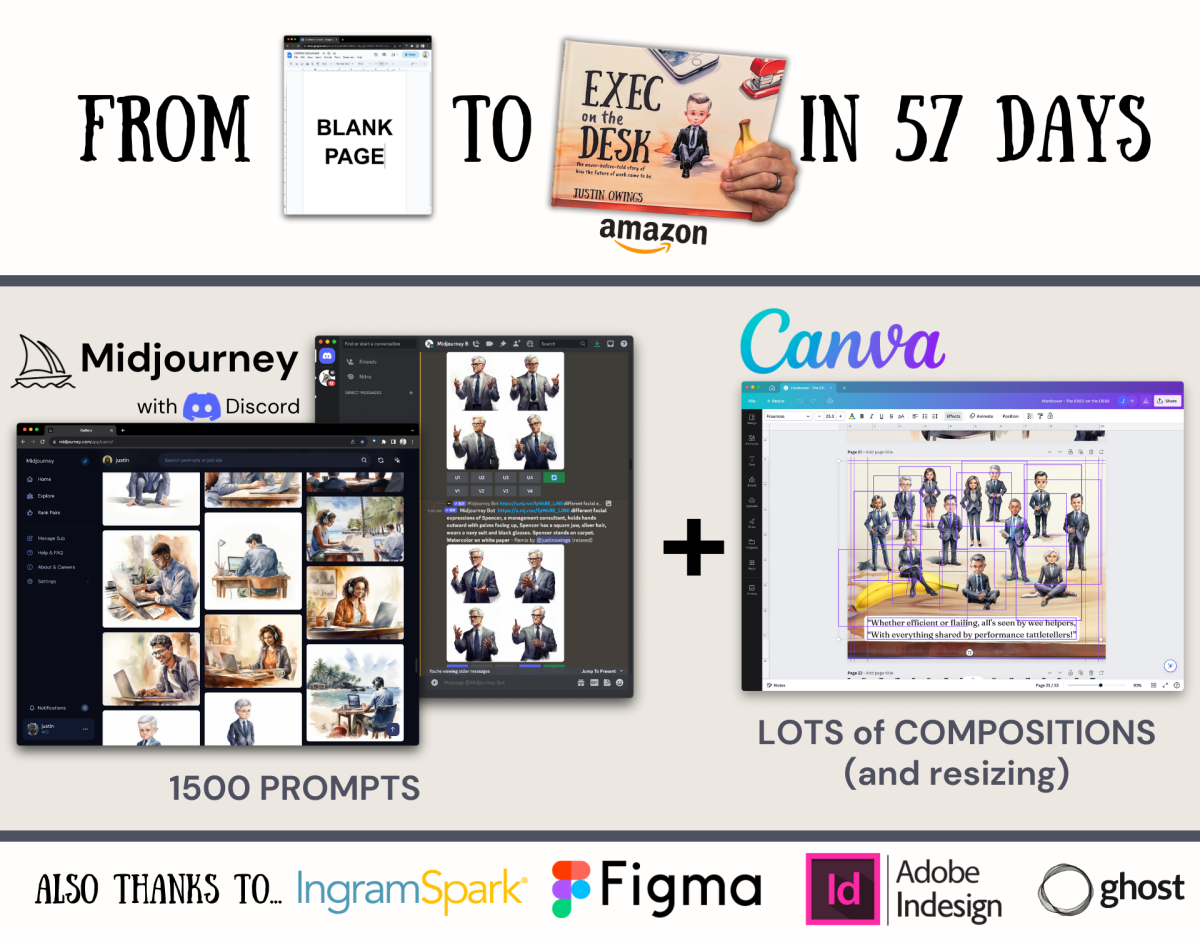You can now speed run from blank page to fully illustrated book, published on Amazon, in 57 days (or less).
How do I know? Because I did it. And even taking nearly two months—and even having never self-published a book before—I estimate it only took around 80 hours of work to do. That’s writing, illustration, and publication with zero outside help (apart from friends and family feedback). I also built a website and social media in this 57 days.
TL;DR
What did it take to get this done?
I had a solid idea—i.e. the concept “Elf on the Shelf meets corporate America.” Mix it up with a backstory involving a magical consultant, the remote work vs. return to office dilemma, and all the typical absurdities of modern work …
The story practically wrote itself. I suppose that’s how the muse is, right?
The magic, for me, was in using AI + easy-to-use software + YouTube to provide the illustrations, the compositional power, and the self-publishing know-how to go from words to fully illustrated, laid out book across three formats.
The details
I have never authored and self-published a book before. But! I’m a creator with 30+ years creating under my belt—going all the way back to my childhood as an “artist.” I was early in the “content” and web publishing game too. I’ve built websites to facilitate content creation for nearly 20 years now. Professionally, I make content for B2B SaaS companies, from blogs to ebooks to microsites and more.
That I could use generative AI (around 1500ish Midjourney prompts) to source my illustrative raw material.
Or that an easy-to-use tool like Canva would make it possible to create near-final layouts I could use for my hardcover (with finalization on Adobe InDesign,
Now I’ve created all kinds of content in the last 20 years. I could not have imagined this was possible a year ago or even 6 months ago.
But here we are. With readily available software (and YouTube for the blind spots) Exec on the Desk is out in the world (Get the book here).
✨
Timeline
Story … I can do this (3 days)
June 27 — Begin a Google Doc and write the ~450 word story in 4 hours. Try Google Bard for ad hoc “rhymes with” help, as needed.
June 30 — 10 hours in, have rough layouts, having created illustrations using Midjourney for the first 7 pages of the book.
Start thinking, “I can create this entire book using AI in about 20 hours.”
Rapidly illustrating a book with AI (12 days)
July 1–12 — Learn that consistent characters for multiple illustrations require patience and lots of tinkering. 😅
Persevere with Midjourney to conjure up McKinsley and then a few dozen Execs.
In total, run between 1200–1500 Midjourney prompts (mostly remixes) to brute-force the creation of raw illustrations to further edit and compose into book layouts. Often do this “on the go”—i.e. running a prompt, walking away, coming back and remixing it, etc.
Note: Midjourney does not like to imagine a single banana. There are ways. 🍌
- Use Canva to compose illustrations and copy, laying out all the pages.
- Use Figma too for a plugin that helps with transparency, as needed.
Feedback + vacation (18 days)
July 13 — Share a draft of near-final book to friends+family for feedback. Based on feedback, revise and improve certain illustrations and compositions. Lots of revisions as perfectionist brain kicks in.
The publishing process (24 days)
July 31 — Begin creating print-ready book for self-publishing on Amazon KDP + IngramSpark.
Make lots of mistakes learning the details of layouts and bleed. Also learn and apply the basics with Adobe InDesign. Thankful for YouTube.
August 7 — Submit proof to IngramSpark. 9 days later receive physical proof of hardback book from IngramSpark to review. 🙌 Had one major layout improvement to make, which added 2-3 days to revise and approve a new proof—but I didn’t even bother with a new physical hardcover proof.
August 18 — Create ebook and paperback for Amazon KDP, order paperback proof.
August 22 — All books confirmed live on Amazon
August 23 — Launch day 🎉


